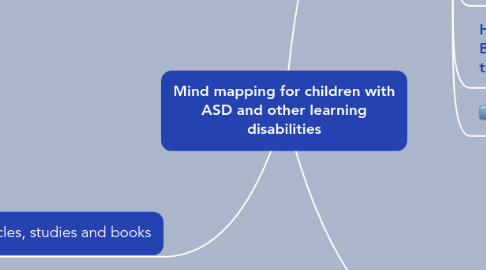
1. Articles, studies and books
1.1. Mind mapping for children with ASD
1.1.1. The Center for Autism and Related Disabilities on visual supports
1.1.2. Mind mapping apps for students with learning disabilities
1.1.3. Study: Gardill, M. C., & Jitendra, A. K. (1999). Advanced Story Map Instruction: Effects on the Reading Comprehension of Students with Learning Disabilities.
1.1.4. Beaney, J. and Kershaw, P. (2003) Positive Thinking Skills. Special, Summer
1.1.5. How ADHD Students Use Mind Mapping Tools at School
1.1.6. Thinking and learning strengths in children with autism spectrum disorder
1.1.7. Temple Grandin: Thinking in Pictures
1.1.8. Visual Supports for People with Autism: A Guide for Parents and Professionals
1.1.9. Brower, F. (2007) 100 Ideas for Supporting Pupils on the Autistic Spectrum. London, Continuum.
1.2. Mind mapping as a teaching tool in general
1.2.1. Scientific Research and Studies - a report by ThinkBuzan Ltd
1.2.2. Report of the National Reading Panel: Teaching Children to Read
1.2.3. Use of premade mind maps to enhance simulation learning
1.2.4. Mind mapping and learning (Johns Hopkins School of Education)
1.2.5. Mind Mapping, the main learning platform at Seabrook Primary School, Australia
1.2.6. Study: “Graphic Organizers: A Review of Scientifically Based Research” (2003)
1.2.7. A summary of Marzano’s “Classroom Instruction That Works”
2. Case Study
2.1. Danny Cayelli
2.2. 13 years old
2.3. High-functioning autism
2.4. Uses mind maps for his reading comprehension assignments
2.5. Has improved his grades from F to B using an online mind mapping tool
2.6. Read the full case study here:
3. Uses and benefits
3.1. Main benefits
3.1.1. See the whole picture
3.1.2. Make out links between single topics
3.1.3. Understand hierarchy and connections
3.1.4. Easy and fun
3.1.5. Learning by doing instead of abstract information
3.1.6. Mental triggers improve memory and recall
3.1.7. More senses involved
3.2. Main uses
3.2.1. Mapping out and expressing thoughts
3.2.2. Brainstorming
3.2.3. Collecting and organizing information
3.2.4. Planning
3.2.5. Problem solving
3.2.6. Dissecting large topics
3.2.7. Memorizing information
3.2.8. Presenting and communicating information
